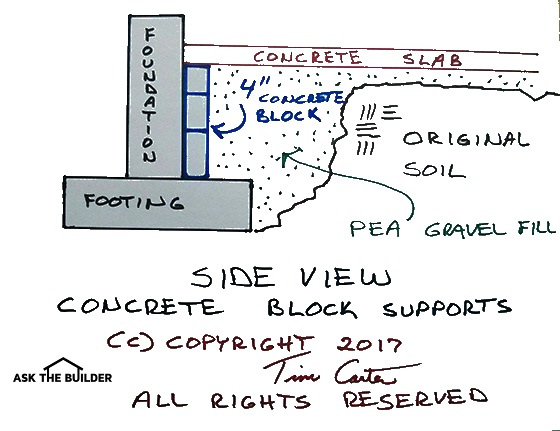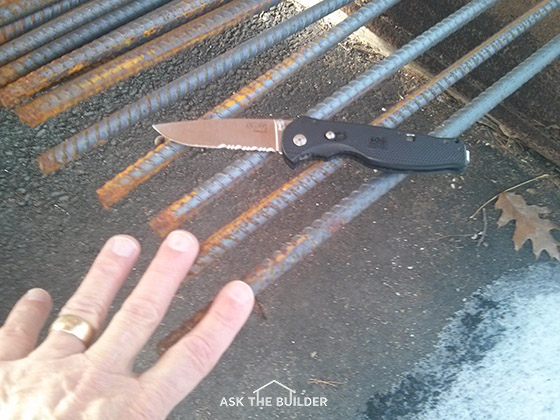Compact Fill Under Slab

The dirt and rock in the center of the future garage has been compacted by Mother Nature for eons. But the trenches next to the new foundation require special care by the builder. © 2017 Tim Carter
Compact Fill Under Slab TIPS
- Concrete bends and breaks
- Use self-compacting fill
- Water helps compact
- Concrete block ledges on footer
- CLICK HERE to Get Tim's FREE & FUNNY Newsletter!
DEAR TIM: My new home is under construction. I'm in a disagreement with my builder about what's going to happen under my garage slab. Right now there's a trench around the inside on all four walls where they had to dig to install the foundation.
The center of the garage area is undisturbed dirt and rock that's been there since the dinosaurs roamed. My builder says he's just going to fill it in with the dirt he dug out and all will be well.
I think that's a mistake. What should be done? If he does use the dirt is there a special way to install it? Are there other things that can be done? What would you do? Tom M., Binghampton, NY
DEAR TOM: Un-compacted fill under concrete slabs of any type is a recipe for disaster. The slab could be for an entire home, it might be an exterior patio slab, a front porch slab, a driveway, etc. Concrete is an amazing material, but it has an Achilles heel.
CLICK HERE to get FREE & FAST BIDS from local concrete slab contractors.
Concrete Weakness
Concrete has tremendous compressive strength. This means if you squeeze it, it often takes 3,000, 4,000 or more pounds of pressure per square inch to get it to crack and fail. But the exact same concrete mix, when you stretch or bend it, engineers call this tension, has on average only one tenth the strength as it has in compression.
Soil Settles
If un-compacted, or poorly compacted, soil or fill sinks under a slab you end up with a hollow spot. If you drive on this concrete and apply pressure to it, the concrete tries to bend or stretch to conform to the hollow spot. The result is almost always a crack and the concrete slab drops down. I see photos of this unnecessary damage all the time.
Add Water to Compact
You're correct that the dirt in the center of the garage area is solid fill. Mother Nature, over time, does an amazing job of compacting soils. Rainwater plays an important part of this process. Adding water to fluffed or disturbed soil will go a long way to accelerate natural compaction of soil particles.
When I was still building on a daily basis, I would go to great lengths to water the fill soil in utility trenches and around the outside of a new home to get the soil to settle faster. Many builders don't take this extra time.
Engineering Specs
Your builder can use the soil he dug out of the ground to fill the trenches back in, but to do it right requires lots of work. A soil engineer can develop a compaction plan that speaks to the amount of soil that can go in the trench at a time, the fancy name for this is a lift, what tool needs to be used to compact the soil and how long the tool needs to be used to get the soil compact.
When fill dirt is placed in large amounts for highways and other projects, the fluffed dirt is brought in, spread out in thin layers and then compacted by large machinery designed to compact dirt and rock. The moisture content of the fill dirt is important as is every other facet of the operation. The same process can be done for smaller jobs like yours.
Your builder has all sorts of options if he doesn't want to go to all that work. Each has to be studied to see which is the most cost effective.
Concrete Block Ledges
One option is to lay concrete block up off the interior ledge of the footers to just below where the concrete slab will be. These can be spaced at 4-foot intervals around the interior foundation walls. The concrete slab will rest on these and provide solid support down to the footer.

Here's a quick drawing I made showing the concrete block ledges. This is a side view showing just one of the supports. You lay block up off the footing so it comes to the bottom of the slab. You place these piers about 4-feet-on-center around the entire slab. Fill the void spaces with self-compacting gravel like the green pea gravel you see. © 2017 Tim Carter
CLICK HERE to get FREE & FAST BIDS from local concrete slab contractors.
Rebar For Sure
The slab will have to have steel rebar, no less than one-half-inch in diameter in both directions spaced at 2-foot centers to make this work. The steel bars need to be placed so they line up with the concrete block pilasters.
The slab then acts as a bridge between the pilasters and the compact dirt in the center of the garage.

This is 1/2-inch rebar. The rods are almost always 20-feet long. Hand and pocket knife for scale. © 2017 Tim Carter
Magic Gravel
The easiest fix to the situation in my opinion is to just fill the trenches with self-compacting gravel. This is what I used to do on my jobs. You may be lucky to have a gravel company that has a truck equipped with a conveyor belt that will shoot the gravel in place so very little work has to be done by hand.
I was lucky to build in an area where there was abundant rounded sand and gravel. This was created by the massive continental glaciers that covered much of the northeast USA and the upper Midwest about 15,000 years ago. When all that ice melted on it's own with no help from us, it created untold cubic yards of this wonderful rounded gravel.
Pea Gravel
I preferred to use washed pea gravel for filling trenches like this in garages. This gravel is the size of small green peas and it naturally compacts as it's put into a void space. Visit a few local gravel pits in your area to see if they have this small rounded gravel.
You can also fill the trenches with a gravel product that's a mixture of washed sand and different sizes of rounded gravel. This product requires water to get it to naturally compact and you need to install it in layers no thicker than one foot at a time.
If you have to use crushed stone, be aware that it requires mechanical compaction so the pieces of gravel interlock. This extra step is costly and it must be done correctly so your slab never fails.
CLICK HERE to get FREE & FAST BIDS from local concrete slab contractors.
Column 1102
4 Responses to Compact Fill Under Slab